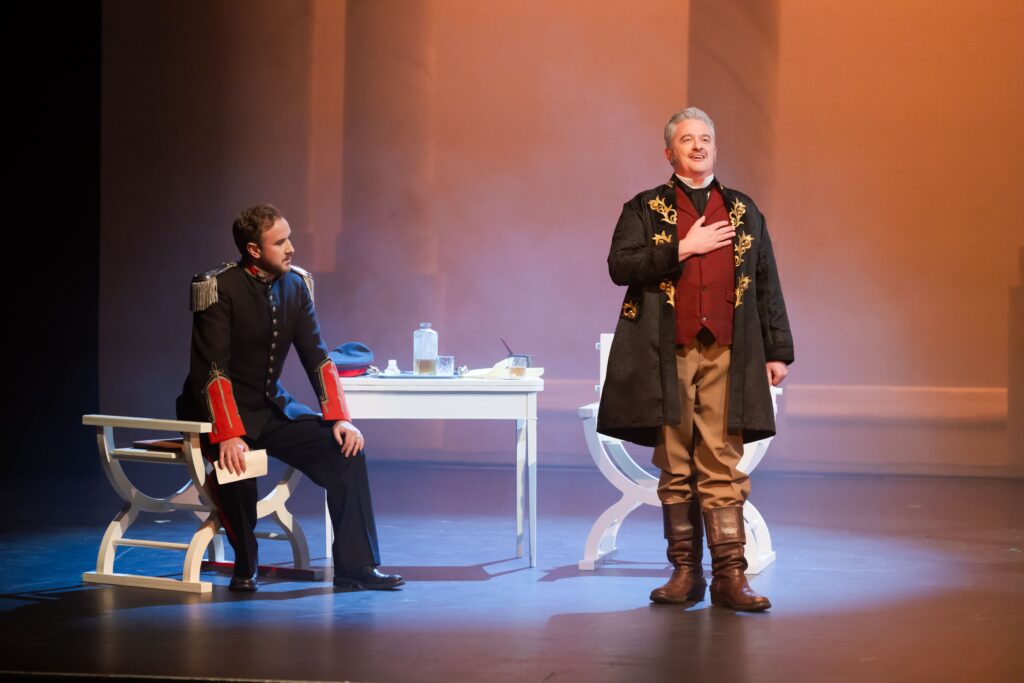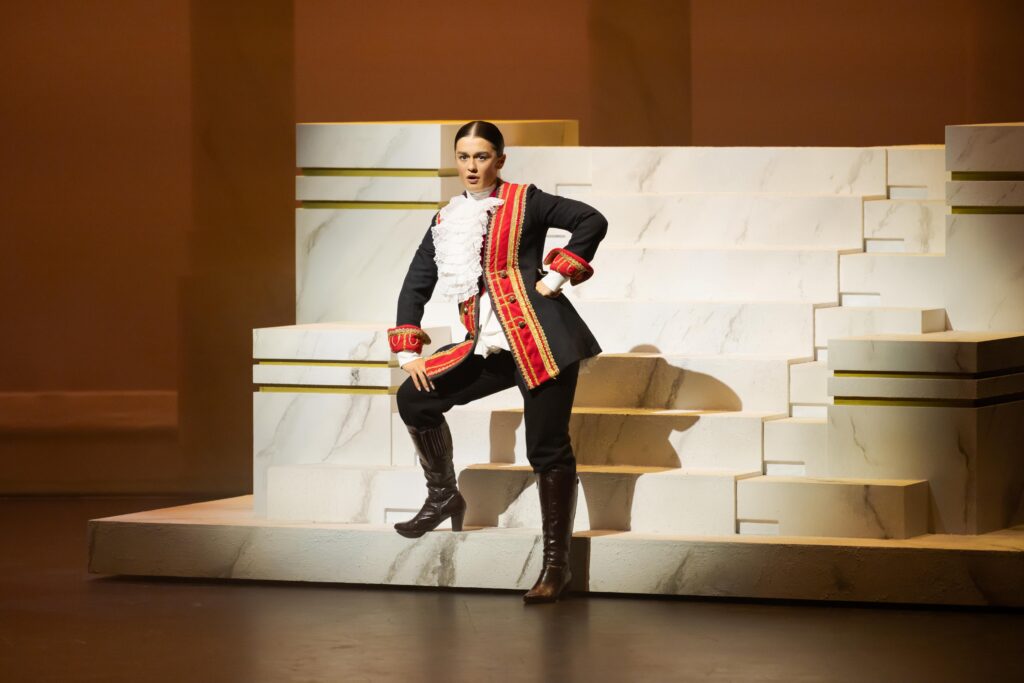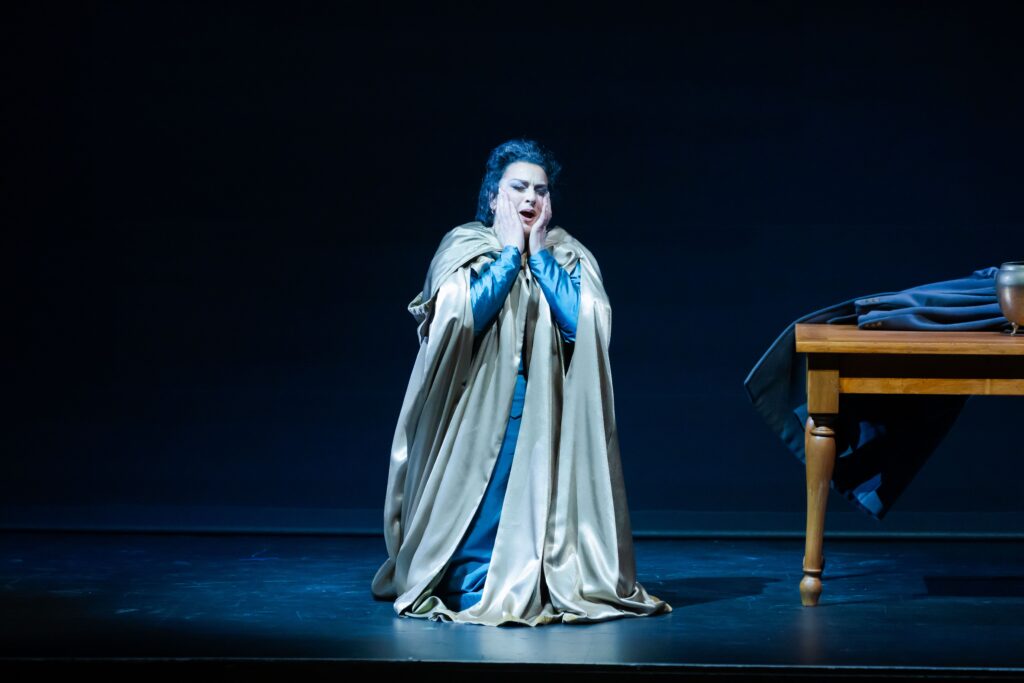 Julien Van Mellearts (Renato) and Jared Holt (King Gustavo)
Julien Van Mellearts (Renato) and Jared Holt (King Gustavo)
photo – Stephen A’Court
Wellington Opera presents:
Giuseppe VERDI – Un Ballo in Maschera (libretto by Antonia Somma)
Jared Holt – Gustavo, King of Sweden
Julien Van Mellearts – Count René Anckarström (Renato), the King’s secretary
Madeleine Pierard – Amelia, the Count’s wife
Natasha Te Rupe Wilson – Oscar, the King’s page
Kristin Darragh – Ulrica Arfvidsson, a sorceress
Samuel McKeever – Count Ribbing, a conspirator
Morgan-Andrew King – Count Horn, a conspirator
Lila Crichton – Judge
Daniel O’Connor – Cristiano, a sailor
Chris Anderson – Amelia’s servant
Director – Jacqueline Coats
Set Design – Michael Zaragoza
Lighting Design – Rowan McShane
Costume Design – Lee Erihäpeti Williams
Conductor – Brian Castles-Onion
Wellington Opera Chorus (Director – Michael Vinten)
Orchestra Wellington
Opera House, Wellington
Friday, 8th August 2025
Wellington’s beautiful Opera House was the venue for the latest offering from the city’s eponymous opera company – Verdi’s Un Ballo in Maschera, which opened on August 6th – I attended the second Opera House performance two evenings later, conscious that the production had had already garnered a good critical response.
Amongst the intriguing advance publicity for the work were references to the production’s use of classical archetypal elements presented in the ancient Greek myth of Artemis and Actaeon, the famous “hunter becomes the hunted” story. The opera’s Prelude accordingly depicts the drama’s monarch, King Gustavo of Sweden, with a pair of hunting dogs, cleverly mirroring this theme at the work’s end with a depiction of the King at a “masked ball” wearing a pair of stag’s antlers, thus symbolising the victim he was to become of a conspiracy amongst his courtiers.
The masks of course underpin another defining motif of the work, that of concealment, one emphasised in a programme note by the production’s director Jacqueline Coats, and given obvious emphasis in the opera’s final definitive ball scene, but also throughout the story in different ways.
Permeating the drama, of course, were the dominant themes of the King’s covert love for Amelia, the wife of his best friend Renato, in tandem with the conspirators’ plot to assassinate their monarch. And various intrigues enriched the action, such as Gustav’s and his courtiers disguising themselves for a visit a fortune-teller who had been threatened with banishment. This in turn led to a midnight tryst between Gustav and Amelia, and their affair’s eventual discovery by Renato, engendering the latter’s secret alignment with the conspirators to bring about Gustav’s end.
From the beginning the drama’s musical fabric was wrought of magic by Orchestra Wellington under conductor Brian Castles-Onion’s direction, the latter never missing a beat or a turn of phrase denoting an action or emotion by his players and singers. The chorus, representing both “allies” and “enemies” of the king, acquitted themselves sonorously as befitted their intentions, the result of Wellington Opera chorusmaster Michael Vinten’s always expert coaching – Jared Holt’s King Gustav replied regally and graciously as the loved-cum-hated monarch, a foil for the initially more workmanlike tones of Julien Van Mellaerts’ Anckarstrom (Renato), the King’s secretary, whose opening canzone “Alla vita che t’arride” was solicitious and dignified as suited the occasion.
 Natasha Te Rupe Wilson (Oscar) – photo, Stephen A’Court
Natasha Te Rupe Wilson (Oscar) – photo, Stephen A’Court
Some of the scene’s most consistently-engaging singing came with Natasha Te Rupe Wilson’s portrayal of Oscar, the King’s Page – the voice and theatrical deportment were a real delight in places such as her defence of the fortune-teller, Ulrica, in her ballata “Volta la terrea fronte alle stelle”, rebuffing the condemnations delivered here somewhat jejunely by Lila Crichton’s Judge. In conclusion Jared Holt was able to generate plenty of devil-may-care energy in his “Ogni cura si doni al diletto”, inviting his courtiers to join him in donning a disguise and visiting the fortune-teller’s lair!
Scene Two, while vividly wrought by the orchestral introduction, seemed to visually fall short of Kirsten Darragh’s vivid descriptions in her “Re dell’abisso, affrettati!”. Nor did the chorus’s “O come tutto riluce di tetro” reflect “how luridly everything glitters” – here, more ice-cold than lurid and infernal, as if this Ulrica was Erda out of Wagner’s “Ring” instead. As with the ensuing scene’s supposedly “campo abbominato”, I thought it all too brightly- and cooly-lit to reflect the “dark and infernal” aspect of the words, though the singers did their best. Ulrica’s palm-reading realisation that the man whose future she was predicting was REALLY doomed was tellingly conveyed by Kirsten Darragh, especially the idea of the killer being his friend! Jared Holt did well with the rebuff of this in his “Ề scherzo od è follia”, his “laughing” tones adroitly conveying his public incredulity at the prophecy.
Madeleine Pierard’s Amelia rose above the discrepancies evident between the scenario of her gathering of the magic herb and her descriptions of it – her opening “Ecco l’oriddo campo ove s’accoppia al delitto la morte!” made me wonder whether the valiant scene-shifters had actually got the right “piece” out on the stage! – hardly suggestive of a place of execution such as a gallows, and with the scene itself surely needing to be darker to reflect Amelia’s terror and loathing (“m’empie di ricappriccio e de terrore!”). She and Jared Holt worked hard at their love-duet that followed without, I felt, recapturing the exhilarating charge of their “Tosca” the previous year here in Wellington, their kiss here far from any kind of “caution abandoned” quality suggested by their words.
By contrast, the arrival of, firstly, Renato to warn the King of danger, and then of the assassins themselves was superbly staged, the overt menace of the latters’ concerted torch-lit aspect making the mordant “comedy” of their discovery of Renato with his wife on a “nocturnal moonlight stroll” all the more delightful – their “laughter”, relished enormously by the audience well aware of the subject couple’s acute anguish, proved a highlight of the evening!
 Madeleine Pierard (Amelia) – photo, Stephen A’Court
Madeleine Pierard (Amelia) – photo, Stephen A’Court
No less riveting was the subsequent exchange between vengeful husband and sorrowing wife, Madeleine Pierard’s “Morro, ma prima in grazia” as deeply-felt and moving as Julien Van Mellearts’s “Eri tu” was by turns impassionedly angry and deeply grief-stricken. And two more voices to impress in the following “plotting” scene were those of the conspirators, Samuel McKeever as Count Ribbing and Morgan-Andrew King as Count Horn – a resoundingly dark-toned duo!
Rivalling these two scenes in impact here was the splendid finale, launched by the brief appearance of the antler-clad King and the appearance of the masked revellers at the ball, the singing and choreography of the chorus again outstanding. Interactions between Oscar (another superb song-and-dance cameo from Natasha Te Rupe Wilson) and Renato over the mystery of the King’s identity further heightening the tensions created by the masked conspirators closing in on their prey with Renato in the van ready to strike, unaware that his victim had already proclaimed Amelia’s innocence by giving her the freedom she desired (touchingly expressed here, at the end, by Jared Holt’s mortally-wounded Gustav.)
No other art-form conveys so many different emotions in simultaneous ferment so exquisitely and heart-rendingly. Given some production aspects that didn’t resonate with me, I still found myself, along with the rest of this evening’s audience, warmly appreciating and acclaiming this “A Masked Ball” as a feast of compelling theatrical action and music-making.